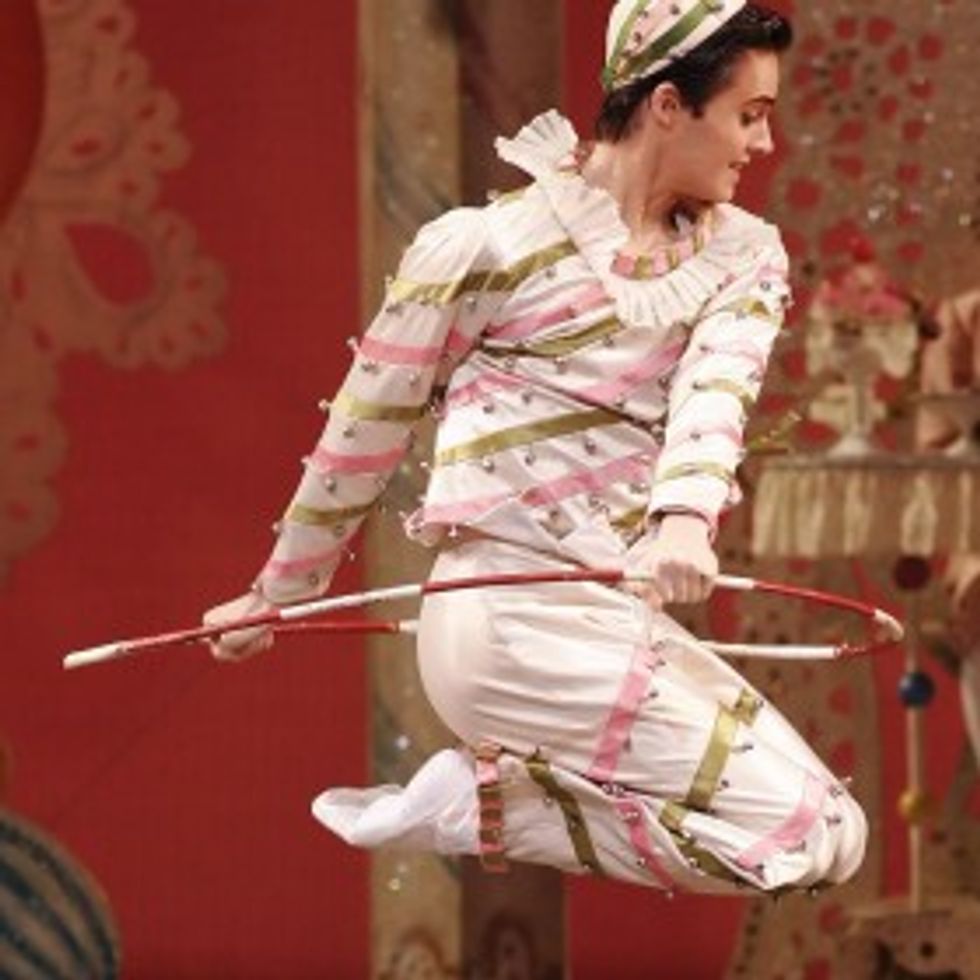Dancer/Composer Aaron Severini

Aaron Severini as the Candy Cane in The Nutcracker. Photo by: Paul Kolnik
Aaron Severini claims the beginning of his dance career was one of those “normal, classic stories”: Boy watches sister do ballet; boy does ballet himself; boy joins New York City Ballet at 17.
But when Severini, a 27-year-old corps member, took a bow this past June at the NYCB Dancers’ Choice performance, it was clear he had strayed away from the “normal, classic” path. For starters, he was in a suit. His dress code usually includes tights, a tunic and ballet shoes. But as he stepped out in front of the New York State Theater’s curtain, Severini bowed for a different reason: A new ballet, “Flit of Fury—The Monarch,” had just been performed to music he composed.
The journey to that moment began almost 10 years ago, behind the curtain at the School of American Ballet’s annual workshop. NYCB Ballet Master in Chief Peter Martins got word about Severini’s talent. “He came up to me backstage and asked me if I wrote music,” Severini says with a sense of disbelief. “It was the first time that someone in a position like that had asked to listen to something of mine.”
Severini’s talent for composition wasn’t a secret, but it also wasn’t his primary focus. In his childhood, he picked up musical skills from his father, a classical guitarist, and started imitating movie scores and tinkering around on the piano. He started composing his own music at age 8.
Severini managed to squeeze in piano lessons between ballet classes. When his family moved to North Carolina, he took his dance training to another level, studying at the North Carolina School of the Arts for two years.
While Severini identified himself as a ballet dancer, a dancer’s very existence includes constant interaction with music. During his adolescence, he found himself plunking out notes to classical ballet scores he learned by ear on studio pianos before class or rehearsal began. But it took moving to NYC and entering class at SAB with legendary teacher Stanley Williams for Severini to hear music in a new way.
“There was so much timing and rhythm,” he says of Williams’ class. “In other classes, the pianists played big stuff like Don Q, but in his class it was much more minimal (like one chord per tendu sometimes), which was very new and influential.”
Fortunately there was an outlet for him to explore the varied styles he was absorbing: All SAB students were required to take a music theory class with Jeffrey Middleton.
“Aaron has an intense energy that comes out in rhythmic propulsion—his music dances,” Middleton says. “He’s also highly opinionated and not easily satisfied, which I consider an asset. He has figured out how to learn what he needs to know. As a dancer he has been immersed in all kinds of music, feeding his imagination.”
While his fellow dancers spent their evenings resting, Severini hunched over a keyboard and worked on compositions he would practice before class the next day. It was because of this that word got back to Martins about the young student’s ability, leading to the inquiry backstage at the workshop. On a day where most students are frenzied, hoping for a contract to the main company, Severini managed to begin his unique path as both a dancer and a composer.
Once he entered the company in 2000, Martins’ interest in Severini grew. “He said any time I had something I was working on I should drop it by his office,” Severini says. “I never expected anything to be taken seriously.” Severini wasn’t even sure if he took himself seriously. But he kept developing a musical style. Each night that he performed a ballet in NYCB’s rep, he got to hear work by musical masters like John Cage, Michael Torke and Steve Reich.
When ballets by these composers filled the program, Severini noticed a shift in himself and his fellow dancers. “There were certain ballets, like Fearful Symmetries, that really got the dancers’ blood going, and I wanted to know why,” he says. “I wanted to get that kind of feeling in my composition: adrenaline-packed, where once it starts it doesn’t stop.”
As the inspiration started coming, so did the opportunities. Martins gave him the chance to compose and (choreograph) for the NYCB’s Choreographic Institute, which led to composing a piece for a Youth America Grand Prix Gala, a show at the National Arts Club and even scoring an online video clip for Rachael Ray.
The culmination of his hard work was his collaboration with fellow dancer and choreographer Adam Hendrickson, titled “Flit of Fury—The Monarch,” which was performed onstage at the State Theater. It gave Severini the ability to demonstrate all he learned from his observations as a dancer and composer: the ability to keep the dancers moving at a frenetic pace, and subsequently keep the audience on the edge of their seats. The New York Times chief critic, Alastair Macaulay, noted “the most remarkable feature seemed to be the rhythmic intricacy of its music, for two pianos, with a nice overlay of jazz elements and Philip Glass–style rapid-fire minimalism.”
Hendrickson realized how unique Severini’s music was after getting the chance to work with him. “He has a lot of energy bottled up in him, and it’s definitely reflected in his music,” he says. “It’s fun to dance to, because it just makes you move.”
All that energy will have the chance to expand over the next year, as Severini plans to explore the world of commercial composition for films, as well as continuing to compose for dance and squeeze in more musical training. Not to mention his career at NYCB.
Phenomenally, he seems poised for as much success in the composition world as he’s had in the dance world.
Matthew Murphy is a freelance writer and photographer living in NYC.




